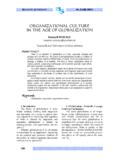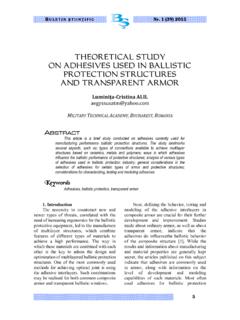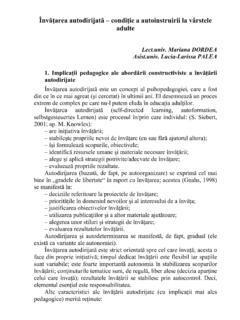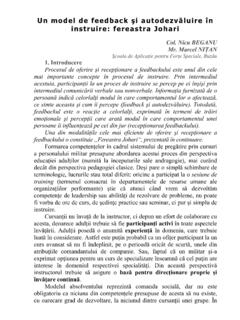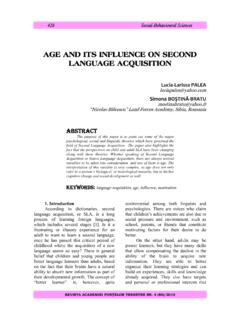Transcription of APPLYING THE MSHARPP METHOD IN RISK …
1 Nr. 1 (39) 2015 buletin TIIN IFIC 11 APPLYING THE MSHARPP METHOD IN RISK ASSESSMENT FOR THE water supply critical INFRASTRUCTURE sector Dorel BADEA* Dumitru IANCU* Olga Maria Cristina BUCOVE CHI** * NICOLAE B LCESCU LAND FORCES ACADEMY, SIBIU, ROMANIA **UNIVERSITY POLITEHNICA OF BUCHAREST, ROMANIA ABSTRACT The paper highlights a manner to assess risks for an important sector of critical infrastructure, that of water supply , frequently regulated in international legal systems. We took into consideration the fact that risk is a problem related to the processes of decision making under conditions of uncertainty in most cases, so that by this approach we bring to the attention of critical infrastructure managers, drawing on their experience, a simple METHOD that can be considered in a preliminary stage of risk assessment specific to water supply . Keywords Risk, criticality, water supply 1. The Fundamental Elements of Risk Approach Although standards in the field clearly provide the essential working vocabulary in risk management, there are still different approaches, more or less justified, on commonly used terminology, and hence the meaning of concepts.
2 In this context, we must necessarily underline the specific difference between risk and vulnerability which arises from the fact that risk refers to threats (origins/causes), characterizing the consequences of their manifestation (loss, damage, suffering), the perception on the importance of consequences and the likelihood of manifestation of threats, while vulnerability relates to the subject / subjects of the exposure to threats manifestation, characterizing the type and level of susceptibility, the reaction to stress of the subject, to withstand the exposure to the manifestation of threats [1]. Nr. 1 (39) 2015 buletin TIIN IFIC 12 Analysis of the risks pertaining to critical infrastructure is therefore connected with the general problem of decision making under conditions of uncertainty. The risks do not exist on an obviously objective manner, but are built by the decision makers, while the parties involved in the decision-making process, possibly non participants in the process but targets of the effects thereof, could perceive this phenomenon as a threat.
3 Of all the methodologies and techniques of risk assessment, the qualitative analysis involves the use of qualitative criteria, using different categories for the separation of parameters using qualitative scales for each category. Also, qualitative decisions are made based on the experience of the assessor with the aim of assigning elements into categories. This type of approach (CARVER, MSHARPP ) is a subjective one, but enables a higher degree of generalization, being less restrictive. 2. Arguments for the Criticality of the Field People, nature and also economic-industrial activities need access to good quality water . In order to produce energy and food and to manufacture the goods that we need every day vast amounts of water are required. Let us also recall that among the first lessons studied in Natural Sciences we became aware of how long we can live without water !
4 In another analysis registry in the system of connections and relationships between different infrastructures , the water energy interdependence is multifaceted. Energy production can affect water quality, but energy is essential to public water supply ( water treatment) and the reduction of pollution through wastewater treatment. Hydro power plays an important and stable role in providing large and secure amounts of green energy. It is estimated [2] that by 2015, only for developing countries 103 billion USD/year are required to finance water supply , sewerage and wastewater treatment. Also in 2011, 768 million people were deprived of controlled sources of drinking water , and billion lacked decent sanitation. Al a national level [3], according to the data available in 2013, Romania s total freshwater resources were estimated at about 212 Km3/year, of which 1844 million cubic meters in natural reservoirs and 7611 million Cubic meters in anthropic lakes (artificial), meaning a total of about 10 km3 of water stored.
5 In a global context, the freshwater resources in Romania are placed at an average level being estimated between 201-500 Km3/year, or between m3 per capita. Also, Romania is located within the European region where the physical scarcity of water is reduced (in 2007 Romania fell within the category of m3/capita). The same source mentions the fact that in 2050, our country does not fall under the risk of depletion of water resources, the estimation on the annual amount available being higher than million liters/capita. According to the National Handbook for water and Sanitation Operators, drafted by the competent Romanian Ministry, assessing crit icalit y wit hin a water and sanitation system means analyzing for each asset or group of assets the following issues: what happens if the asset crashes; what the chances are that it crashes; if the asset crashes, how many beneficiaries are affected; if the asset crashes what would be the repair costs; if the asset crashes, what other assets might be damaged; if the asset crashes, what are the consequences on the environment and human health.
6 Criticality analysis has several important roles including that it allows the regional operator to manage risks and helps establish a more efficient way of allocating funds for rehabilitation and replacement [4]. Nr. 1 (39) 2015 buletin TIIN IFIC 13 3. Technical Considerations on water supply The public water supply or sewerage network is part of the public water supply system, sewage system respectively, made up of the pipeline network, valves and additional buildings which ensure water distribution, takeover, disposal and transport of sewage water to/from two or more independent users, respectively from two or more individuals who live in individual houses or from two or more legal entities administering one single condominium, as it is defined by the law. The biggest problems that the field of water supply is facing today, are due, in particular, to [5]: the exponential growth of water demand; the limited water resources and their uneven distribution, which requires large and expensive works of water accumulation and earthworks; the deterioration in the quality of water sources as a result of human activity and the emergence of industries which discharge waste containing highly stable impure substances, difficult to remove from the water within the purification or water treatment processes; the increase in standards on quality conditions that water delivered to the populat ion must comply with.
7 The components of a water supply network (Figure no. 1), as well as those of a sewage network are usually located on public domain; where technical and economic conditions are favorable public network water supply or sewage may be located, with the consent of the owner, also on private land. Figure no. 1: The structure of a typical municipal water station [6] Nr. 1 (39) 2015 buletin TIIN IFIC 14 The public drinking water supply system includes the ensemble of buildings and lands, technological installations, functional equipment and specific facilities, which ensure the public drinking water supply service. The public drinking water supply system usually contains the following components [7]: dams, culverts, raw water treatment plants, pumping stations, with or without pump, water storage tanks, distribution networks and connections to the point of demarcation.
8 4. APPLYING the MSHARPP METHOD The MSHARPP analysis aims to measure threats to a target of particular importance in terms of the infrastructure holder, depending on the extent of the criteria that make up the acronym (M mission; S symbolism; H history; A accessibility; R recognizability; P population; P proximity). Each criterion is assigned a value of one to five, five being the higher level of vulnerability and one the lowest level of vulnerability. In analyzing the criteria the following significance of values is used (grades from one to five): [8], [9] the destruction or activity disruption of the objective has no effect on its ability to fulfill its mission (1); the objective can continue its mission if attacked, but with a lower yield (2) ; the objective operates at half of its maximum capacity, as a result of an attack (3); the objective s ability to fulfill its mission is largely hindered (4); the objective can not continue its mission (5).
9 In a possible scenario, risk assessment of a town/county water company by APPLYING this METHOD brings attention to the following applicative aspects: the mission is to serve under optimal conditions the population, businesses and public institutions in the respective company's operating area; the symbolism refers to the fact that the organization can be the main provider of drinking and household water in the county; the history points out that the water sector is not a major focus of the attacks, but it can be explo ited if it presents major vulnerabilities; accessibility shows a low level of security and the company headquarters is most often located near a communication means; recognizability indicates an easy location with the help of maps and the internet, distinctive signs to identify the nature of the objective are present; population has the characteristic of a small number of employees who have a low exposure to external threats.
10 Proximity is assessed by the fact that the objective is located at about 1-3 kilometers from the residence town and in its vicinity there are no other buildings. Summarizing these considerations, based on the significance of values allocat ion, the matrix below is obtained. Table no. 1 Application of the METHOD for a water supply system Objective MSHARPPT otal Sewage networks 211455321 Raw water pumping station311243115 Flocculation basin 211233214 Sedimentation basin 311233215 water purification basin511233217 Disinfection basin 111233213 Finished water basin 313333218 Distribution network513255326 Nr. 1 (39) 2015 buletin TIIN IFIC 15 Following the MSHARPP analysis for the case considered, we note that the increased vulnerability lies within the distribution network, due to its vital importance in carrying out the mission of population water supply and the population affected by its malfunctioning.
